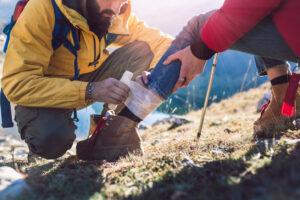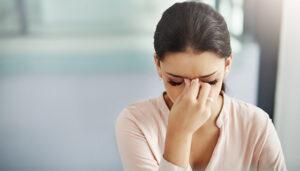
You’re probably thinking, don’t you just train for hiking by going on hikes? You’re correct, however, if you’re just getting into hiking or you aspire to do longer hikes to loftier places, then doing some preseason training can be a huge help.
This workout plan, inspired by our friends at REI, is designed to target areas that power you up the trail mile after mile. Increase your core strength, major leg muscles, and build endurance with these easy exercises. Complimenting this routine with cardio exercises is vital since hiking is an aerobic exercise. Enjoy summer activities like trail running, swimming, or mountain biking to prepare for your hike!
Before beginning any training, consult with a physiotherapist near you to make sure your body is healthy and in alignment!
Training schedule for hiking
It is recommended that you start training 8 weeks before your first long hike. A good mix of workout types for each week involves the following:
- 2 non-consecutive days of strength training (exercises listed in this article)
- 3 non-consecutive cardio sessions weekly (until the final two weeks before a major hike)
- 2 non-consecutive rest days (take more rest any time you feel your body needs it)
Two weeks before your trip it is recommended that you change those cardio days to long day hikes (60+ minutes each) with a pack that’s close to the weight you’ll be carrying on your trip. If you’re feeling great, tack on a fourth day-hike training session to one of your strength-training days.
One or two days prior to your trip you should ease up on all training.
As you start training, listen to your local physiotherapists voice in your ear reminding you to…
- Make the exercises fit your body, not the other way around.
- If something hurts, modify the exercise, or skip it.
- Move at your own pace and start slow. Increase the repetitions or add more resistance as your training progresses.
7 best training exercises for hiking
Warm up
Never forget to warm-up! A brisk 10-minute walk is the perfect way to get your body moving before diving into these exercises. Follow the guidelines below as you progress through the movements in this article:
- Inhale during initial exertion, then exhale as you return to the starting position; during faster exercises, breathe regularly.
- Rest for 30 to 45 seconds at the end of each exercise.
- Do each of the exercises below one time in succession, then rest for two minutes and repeat another set of the exercises (if you have time to fit in a third set of exercises, even better!)
1. Jump Squats
Squats find their way into almost every exercise plan because they provide an excellent all-around workout for all the muscles in the lower body and legs—your body’s hiking engine. Adding a jump helps further develop power in the lower legs.
- Start with your feet shoulder-width apart and then squat down until your thighs are parallel with the ground.
- Keep your chest up, feet flat, and knees over your toes.
- As you come up from the squat, push through heels and explode up and jump a few inches off the ground.
- Land softly and quietly, and immediately go into another squat.
- Complete 15-20 times.
2. Step Up Exercise
Hiking involves an endless amount of stepping up and over things. This exercise builds strength and endurance in your quad muscles and glutes so you can handle whatever obstacles you’ll encounter along the trail.
Props: A stable surface, about 8 inches off the ground. If you have a training box or an aerobic step at home, you can use that. If not, the bottom step on a flight of stairs works.
- Start with your L foot on the ground and your R foot on top of the step; your R knee will be bent.
- Step up until you are standing with your R leg nearly straight, and you are balanced on top of the step; your L leg should be bent slightly and your L foot poised an inch or so above the step.
- Pause in a balanced position, then step down, returning your L leg and R foot to the starting position.
- Do this 15 times; then repeat the exercise 15 times on the other side.
Tip: Adjust the difficulty by finding a higher or lower surface to step on.
3. Hip Roll Exercise
Most of your daypack weight rides on your hips. This exercise works the glutes and other muscles that support the hips to improve their stability and endurance.
- Stand on your L leg.
- Lean your body forward at your hips, keeping back straight and lift your R leg back behind you, slightly off the ground.
- Rotate (roll) your hip away from your standing foot.
- Keep your body in a straight plane as you roll your hips back.
- Repeat 10-15 times on each side.
Tip: If it’s too hard to balance, hold onto the back of a chair or keep your toes on the ground.
4. Heel Down Exercise
In order to get down after you step on top of a boulder or log, you need to be able to lower your body and pack weight under control. This control is key to preventing knee injuries. The heel down exercise works your glutes and quad muscles so you have the strength and balance to move down smoothly.
Props: A stable surface, about 8 inches off the ground (same as exercise #2)
- Start by standing on top of a step, balanced on your R foot with your L foot hovering to the side.
- Lift the toes on your L foot up, then bend your R knee as you slowly lower your L leg until your L heel is barely touching the ground or poised just above it.
- Power back up with your R leg until you are back to the starting position.
- Do this 15 times; then repeat the exercise 15 times on the other side.
5. Squat Curl Overhead Press Exercise
This exercise works to build the full-body strength you’ll need as you explore the trails and take your daypack on and off throughout the day.
Props: Lightweight dumbbells
- Stand with feet shoulder-width apart, arms at your side, holding a dumbbell in each hand.
- Press your hips back and squat down, thighs parallel to the floor.
- Power back up to a standing position, using your upward momentum to assist you as you curl up and then press the dumbbells overhead with palms facing each other the entire time.
- Return to starting position and repeat 10-15 times.
Tip: Keep your back and neck in a neutral position. Don’t let your knees go past your toes when you’re squatting.
6. Side Plank with Leg Raise Exercise

Planks build key muscles like the obliques, glutes, and leg muscles. This plank variation adds a leg raise to build endurance in the muscles that move and support your hips.
- Lie on your R side, supported by your elbow under your shoulder; your R forearm should be perpendicular to your body; your L hand should rest on your L hip, with your L elbow pointing up; your legs and feet should be stacked atop one another.
- Tighten your core as you raise your hips up into a plank, creating a straight line from your head to feet.
- Slowly raise your L leg up and slightly back, keeping it straight as you do so. Keep your hips still.
- Lower your leg and raise it a total of 10 times.
- Repeat the exercise lying on your left side for 10 more reps.
Tip: Adjust the difficulty by adjusting how high you raise your top leg each time.
7. Hip Clock Exercise
Many hikers complain of knee soreness and fatigue. This exercise builds strength in the hips, which helps prevent knee issues by giving you better control over your knees.
- Stand with your weight balanced on your L leg with that knee slightly bent.
- Keep your back straight and weight centered over the standing knee.
- Imagine that you’re at the center of a clock. Lift and extend your R leg, reaching forward toward 12 o’clock.
- Bring your leg back to the center.
- Repeat the movements toward the 3, 6, and 9 o’clock positions. As you reach for each position, stay balanced over the standing leg, and don’t let your hips shift side-to-side.
- Switch to the other leg and repeat; do 5 to 8 sets on each leg.
Tip: Keep your hips level and push into the ground with your standing foot for balance. Make smaller leg movements if you feel off balance.
Schedule a physio appointment with Synergy Rehab
Want to make sure your body is in tip top condition for your hike? Schedule an appointment with one of our expert physiotherapists near you today! We’ve got your








